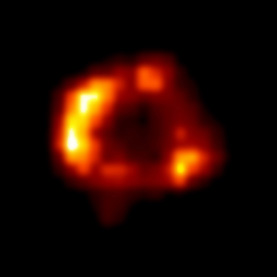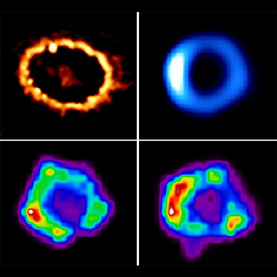Imagine the Universe! News Desk
Chandra Views a Supernova Remnant
in the Making
| 12 May 2000 |

|
(Credit: NASA/PSU/D. Burrows et al.) |
Images made by NASA's Chandra X-ray Observatory show for the first time the full impact of the blast wave from Supernova 1987A (SN1987A). The observations are the first time that X-rays from a shock wave have been imaged at such an early stage of a supernova explosion. Astronomers are thrilled to see these images showing the progress of a supernova remnant in the making.
SN1987A has been followed closely by astronomers since its appearance in early 1987. It is located in the Large Magellanic Cloud, our nearest galactic neighbor visible from the Southern Hemisphere. About 200 days after the initial appearance of the supernova, the International Ultraviolet Explorer detected evidence for a ring of material around the remains of the star. This ring had been ejected thousands of years earlier in the death-throws of the star, but was only illuminated after the explosion.
X-rays were first detected from SN1987A in 1992 by ROSAT. The X-rays are emitted by hot gas (with temperatures of 10 million degrees Celsius) following behind the shock wave emitted by the supernova explosion. It has been expected that this shock wave would continue to expand through the years.
Recent observations of SN 1987A with the Hubble Space Telescope revealed gradually brightening of hot spots in the ring of matter. Chandra's X-ray images show the cause for this brightening ring. The shock wave is smashing into portions of the ring at a speed of 10 million miles per hour (4,500 kilometers per second).
"With Hubble we heard the whistle from the oncoming train," said David Burrows of Pennsylvania State University, University Park, the leader of the team of scientists involved in analyzing the Chandra data on SN 1987A. "Now, with Chandra, we can see the train."
|
|

|
|
Upper Left - HST image of matter ring taken in Feb 2000; Upper Right - Australian Telescope Compact Array radio image taken Sep 1999; Lower Right - Chandra False Color Image from 6 Oct 1999 Lower Left - Chandra False Color Image from 17 Jan. 2000. (Credits: Optical:NASA/CfA/P.Challis et al; Radio: MIT/ATN/Gaensler & Manchester; X-ray: NASA/PSU/D. Burrows et al.) |
The X-ray observations appear to confirm the general outlines of a model developed by team member Richard McCray of the University of Colorado, Boulder, and others, which holds that a shock wave has been moving out ahead of the debris expelled by the explosion. As this shock wave collides with material outside the ring, it heats it to millions of degrees. "We are witnessing the birth of a supernova remnant for the first time," McCray said.
The Chandra images clearly show the previously unseen, shock-heated matter just inside the optical ring. Comparison with observations made with Chandra in October and January, and with Hubble in February 2000, show that the X-ray emission peaks close to the newly discovered optical hot spots, and indicate that the wave is beginning to hit the ring.
In the next few years, the shock wave will light up still more material in the ring, and an inward moving, or reverse, shock wave will heat the material ejected in the explosion itself. "The supernova is digging up its own past," said McCray.
The observations were made on October 6, 1999, using the Advanced CCD Imaging Spectrometer (ACIS) and the High Energy Transmission Grating, and again on January 17, 2000, using ACIS. Other members of the team were Eli Michael of the University of Colorado; Dr. Una Hwang, Dr. Steven Holt and Dr. Rob Petre of NASA's Goddard Space Flight Center in Greenbelt, MD; and Professors Gordon Garmire and John Nousek of Pennsylvania State University. The results will be published in an upcoming issue of the Astrophysical Journal.

